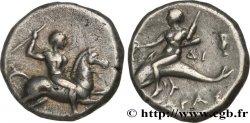Live auction - bgr_1070304 - CALABRIA - TARAS Nomos, statère ou didrachme
You must signin and be an approved bidder to bid, LOGIN TO BID. Accounts are subject to approval and the approval process takes place within 48 hours. Do not wait until the day a sale closes to register. Clicking on "BID" constitutes acceptance of the terms of use of cgb.fr private live auctions.
Bids must be placed in whole Euro amounts only. The sale will start closing at the time stated on the item description; any bids received at the site after the closing time will not be executed. Transmission times may vary and bids could be rejected if you wait until the last second. For further information check the Live auction FAQ
All winning bids are subject to a 18% buyer’s fee.
All winning bids are subject to a 18% buyer’s fee.
Type : Nomos, statère ou didrachme
Date: c. 281-228 AC.
Mint name / Town : Tarente, Calabre
Metal : silver
Diameter : 19,5 mm
Orientation dies : 1 h.
Weight : 7,16 g.
Rarity : R3
Coments on the condition:
Monnaie bien centrée des deux côtés. Très beau portrait ainsi qu’un revers agréable. Patine grise
Catalogue references :
Obverse
Obverse description : Tête de nymphe à gauche, les cheveux retenus par un diadème et une sphendoné.
Obverse legend : EU
Reverse
Reverse description : Cavalier nu au pas à gauche, couronnant son cheval ; petit dauphin à droite sous le cavalier et une grappe de raisin devant le cheval.
Reverse legend : TA
Commentary
La tête au droit rappelle certains didrachmes de Naples frappés entre 340 et 241 avant J.-C. Au revers, c’est le cavalier et non pas Taras qui symbolise Tarente. Mêmes coins que l’exemplaire de la collection Vlasto n° 1028, pl. XXXIII.
The head on the obverse is reminiscent of certain Neapolitan didrachms minted between 340 and 241 BC. On the reverse, it is the horseman, not Taras, who symbolizes Tarentum. Same dies as the specimen in the Vlasto collection, no. 1028, pl. XXXIII
The head on the obverse is reminiscent of certain Neapolitan didrachms minted between 340 and 241 BC. On the reverse, it is the horseman, not Taras, who symbolizes Tarentum. Same dies as the specimen in the Vlasto collection, no. 1028, pl. XXXIII








 Live starting :
Live starting :  Report a mistake
Report a mistake Print the page
Print the page Share my selection
Share my selection Ask a question
Ask a question Consign / sell
Consign / sell
 Full data
Full data













